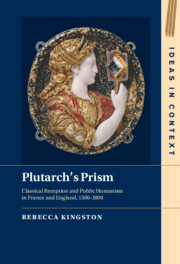Book contents
- Plutarch’s Prism
- Ideas in Context
- Plutarch’s Prism
- Copyright page
- Contents
- Figures
- Preface
- Acknowledgements
- Introduction
- Part I Setting the Stage
- Part II Plutarch in Renaissance France and England
- Chapter 3 Plutarch in Early French Renaissance Public Humanism: Geoffroy Tory and Guillaume Budé
- Chapter 4 Plutarch in Early French Renaissance Public Humanism: Desiderius Erasmus and Claude de Seyssel
- Chapter 5 Tudor Plutarch
- Chapter 6 Plutarch in Later French Humanism and Reformation: Georges de Selve, Jacques Amyot and Jean Bodin
- Chapter 7 Bernard de Girard Du Haillan and Michel de Montaigne on Thinking Through the Public Good in a Time of Civil Discord
- Part III Seventeenth- and Eighteenth-Century Plutarch
- Bibliography
- Index
Chapter 6 - Plutarch in Later French Humanism and Reformation: Georges de Selve, Jacques Amyot and Jean Bodin
from Part II - Plutarch in Renaissance France and England
Published online by Cambridge University Press: 22 September 2022
- Plutarch’s Prism
- Ideas in Context
- Plutarch’s Prism
- Copyright page
- Contents
- Figures
- Preface
- Acknowledgements
- Introduction
- Part I Setting the Stage
- Part II Plutarch in Renaissance France and England
- Chapter 3 Plutarch in Early French Renaissance Public Humanism: Geoffroy Tory and Guillaume Budé
- Chapter 4 Plutarch in Early French Renaissance Public Humanism: Desiderius Erasmus and Claude de Seyssel
- Chapter 5 Tudor Plutarch
- Chapter 6 Plutarch in Later French Humanism and Reformation: Georges de Selve, Jacques Amyot and Jean Bodin
- Chapter 7 Bernard de Girard Du Haillan and Michel de Montaigne on Thinking Through the Public Good in a Time of Civil Discord
- Part III Seventeenth- and Eighteenth-Century Plutarch
- Bibliography
- Index
Summary
Chapter 6 continues an account of the reception of Plutarch’s work in the mid to late sixteenth century in France with reference to the translation work and political reflection of figures such as Georges de Selve (1508–1541) (now famous as one of the figures in Holbein’s famous painting “The Ambassadors”). The latter part of the chapter discusses what is perhaps the best-known moment of Plutarch reception, the French vernacular translations of the Lives (1559–1565) and Moralia (1572) by Jacques Amyot (1513–1593). I discuss how the advent of the Wars of Religion (1562–1598) in France affected the themes through which Plutarch was received and read in Renaissance France, partly through an examination of the para-text of Amyot’s translations in the late sixteenth century. I also explore briefly Jean Bodin’s discussion of ther reliability of Plutarch as a source as noted in his Method for the Easy Comprehension of History.
Keywords
- Type
- Chapter
- Information
- Plutarch's PrismClassical Reception and Public Humanism in France and England, 1500–1800, pp. 233 - 260Publisher: Cambridge University PressPrint publication year: 2022



